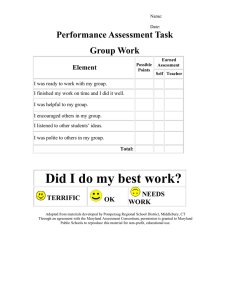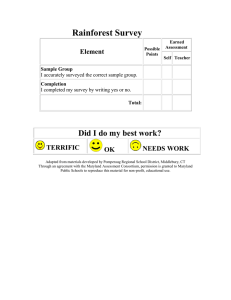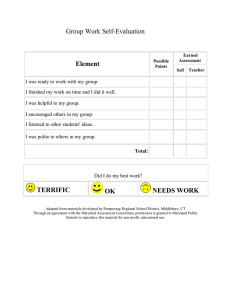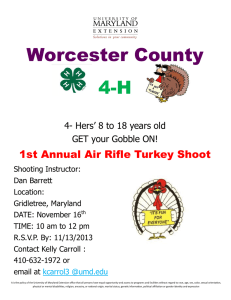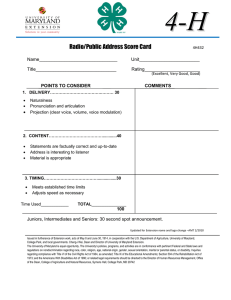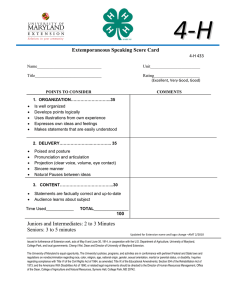Instructions for 2015 Form 1 Personal Property Return
advertisement
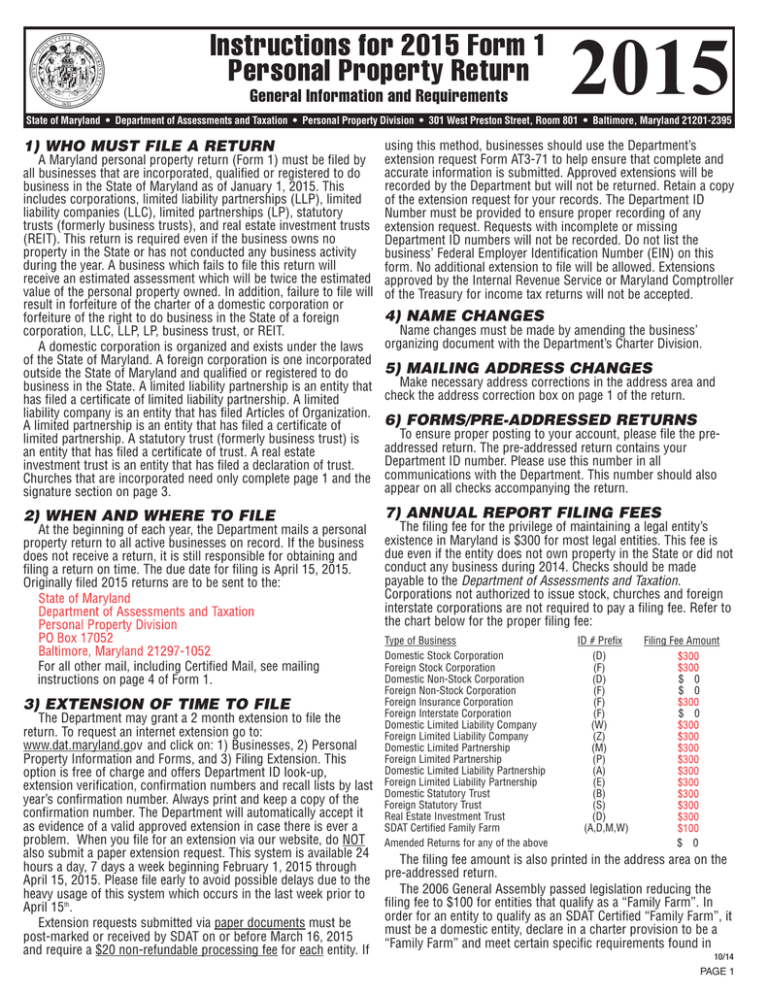
Instructions for 2015 Form 1
Personal Property Return
General Information and Requirements
2015
State of Maryland s Department of Assessments and Taxation s Personal Property Division s 301 West Preston Street, Room 801 s Baltimore, Maryland 21201-2395
1) WHO MUST FILE A RETURN
A Maryland personal property return (Form 1) must be filed by
all businesses that are incorporated, qualified or registered to do
business in the State of Maryland as of January 1, 2015. This
includes corporations, limited liability partnerships (LLP), limited
liability companies (LLC), limited partnerships (LP), statutory
trusts (formerly business trusts), and real estate investment trusts
(REIT). This return is required even if the business owns no
property in the State or has not conducted any business activity
during the year. A business which fails to file this return will
receive an estimated assessment which will be twice the estimated
value of the personal property owned. In addition, failure to file will
result in forfeiture of the charter of a domestic corporation or
forfeiture of the right to do business in the State of a foreign
corporation, LLC, LLP, LP, business trust, or REIT.
A domestic corporation is organized and exists under the laws
of the State of Maryland. A foreign corporation is one incorporated
outside the State of Maryland and qualified or registered to do
business in the State. A limited liability partnership is an entity that
has filed a certificate of limited liability partnership. A limited
liability company is an entity that has filed Articles of Organization.
A limited partnership is an entity that has filed a certificate of
limited partnership. A statutory trust (formerly business trust) is
an entity that has filed a certificate of trust. A real estate
investment trust is an entity that has filed a declaration of trust.
Churches that are incorporated need only complete page 1 and the
signature section on page 3.
2) WHEN AND WHERE TO FILE
At the beginning of each year, the Department mails a personal
property return to all active businesses on record. If the business
does not receive a return, it is still responsible for obtaining and
filing a return on time. The due date for filing is April 15, 2015.
Originally filed 2015 returns are to be sent to the:
For all other mail, including Certified Mail, see mailing
instructions on page 4 of Form 1.
3) EXTENSION OF TIME TO FILE
The Department may grant a 2 month extension to file the
return. To request an internet extension go to:
www.dat.maryland.gov and click on: 1) Businesses, 2) Personal
Property Information and Forms, and 3) Filing Extension. This
option is free of charge and offers Department ID look-up,
extension verification, confirmation numbers and recall lists by last
year’s confirmation number. Always print and keep a copy of the
confirmation number. The Department will automatically accept it
as evidence of a valid approved extension in case there is ever a
problem. When you file for an extension via our website, do NOT
also submit a paper extension request. This system is available 24
hours a day, 7 days a week beginning February 1, 2015 through
April 15, 2015. Please file early to avoid possible delays due to the
heavy usage of this system which occurs in the last week prior to
April 15th.
Extension requests submitted via paper documents must be
post-marked or received by SDAT on or before March 16, 2015
and require a $20 non-refundable processing fee for each entity. If
using this method, businesses should use the Department’s
extension request Form AT3-71 to help ensure that complete and
accurate information is submitted. Approved extensions will be
recorded by the Department but will not be returned. Retain a copy
of the extension request for your records. The Department ID
Number must be provided to ensure proper recording of any
extension request. Requests with incomplete or missing
Department ID numbers will not be recorded. Do not list the
business’ Federal Employer Identification Number (EIN) on this
form. No additional extension to file will be allowed. Extensions
approved by the Internal Revenue Service or Maryland Comptroller
of the Treasury for income tax returns will not be accepted.
4) NAME CHANGES
Name changes must be made by amending the business’
organizing document with the Department’s Charter Division.
5) MAILING ADDRESS CHANGES
Make necessary address corrections in the address area and
check the address correction box on page 1 of the return.
6) FORMS/PRE-ADDRESSED RETURNS
To ensure proper posting to your account, please file the preaddressed return. The pre-addressed return contains your
Department ID number. Please use this number in all
communications with the Department. This number should also
appear on all checks accompanying the return.
7) ANNUAL REPORT FILING FEES
The filing fee for the privilege of maintaining a legal entity’s
existence in Maryland is $300 for most legal entities. This fee is
due even if the entity does not own property in the State or did not
conduct any business during 2014. Checks should be made
payable to the Department of Assessments and Taxation.
Corporations not authorized to issue stock, churches and foreign
interstate corporations are not required to pay a filing fee. Refer to
the chart below for the proper filing fee:
Type of Business
Domestic Stock Corporation
Foreign Stock Corporation
Domestic Non-Stock Corporation
Foreign Non-Stock Corporation
Foreign Insurance Corporation
Foreign Interstate Corporation
Domestic Limited Liability Company
Foreign Limited Liability Company
Domestic Limited Partnership
Foreign Limited Partnership
Domestic Limited Liability Partnership
Foreign Limited Liability Partnership
Domestic Statutory Trust
Foreign Statutory Trust
Real Estate Investment Trust
SDAT Certified Family Farm
Amended Returns for any of the above
ID # Prefix
(D)
(F)
(D)
(F)
(F)
(F)
(W)
(Z)
(M)
(P)
(A)
(E)
(B)
(S)
(D)
(A,D,M,W)
Filing Fee Amount
$
$
0
0
$ 0
$
0
The filing fee amount is also printed in the address area on the
pre-addressed return.
The 2006 General Assembly passed legislation reducing the
filing fee to $100 for entities that qualify as a “Family Farm”. In
order for an entity to qualify as an SDAT Certified “Family Farm”, it
must be a domestic entity, declare in a charter provision to be a
“Family Farm” and meet certain specific requirements found in
10/14
3$*(
§1-209 of the Corporations and Associations Article. Entities can
qualify at the time of formation or via a charter amendment for an
existing domestic entity. Please refer to the Businesses section of
the Department’s website for more specific information.
8) LATE FILING PENALTIES
A business which files an annual return postmarked after the
due date of April 15, 2015 will receive an initial penalty of 1/10 of
one percent of the county assessment, plus interest at the rate of
two percent of the initial penalty amount for each thirty (30) days
or part thereof that the return is late. If returns are filed late, do
not prepay penalties. They will be assessed at a later date.
9) PERIOD COVERED
All returns shall cover the calendar year regardless of any fiscal
year. All information required in this return shall be given as of
January 1, 2015 except line items and which refer to the
twelve calendar months of 2014. This return must be accompanied
by Form 4A and 4B (Balance Sheet and Depreciation Schedule)
provided with the return unless the business does not own any
personal property in Maryland. A substitute Balance Sheet,
including Schedule L from IRS Form 1120, may be used, however
Form 4B (Depreciation Schedule) must be completed. Information
supplied on the second, third and fourth pages and enclosures are
not open to public inspection. If the Balance Sheet reflects
property outside the State of Maryland, please reconcile with the
property reported on the return.
10) WHAT MUST BE REPORTED
Generally all tangible personal property owned, leased,
consigned or used by the business and located within the State of
Maryland on January 1, 2015 must be reported. Property not in
use must still be reported. All fully depreciated and expensed
personal property must also be reported. Personal property
includes but is not limited to office and plant furniture, machinery,
equipment, tools, furnishings, trade fixtures, inventory, and all
other property not considered part of the real estate.
Personal property in this State (other than operating property of
railroads and public utilities) falls into two subclasses:
Stock in business or inventory is goods held by a taxpayer for
sale and goods placed on consignment to another for sale in the
expectation of a quick turnover. Stock in business does not include
goods manufactured by the taxpayer but held by the taxpayer for
purposes other than sale or goods manufactured by the taxpayer
but placed in possession and control of another as in the case of
leased property. Stock in business is assessed at cost or market
value whichever is lower. LIFO method of valuation is prohibited.
All other personal property includes all personal property other
than inventory and is assessed at full cash value. Taxpayers shall
report such property which has been acquired by purchase at cost
in the year of acquisition. Taxpayers shall report such property
which has been acquired other than by purchase (including
property manufactured by the taxpayer) at what the property
would have sold for in the year of acquisition. To assess “all other
personal property” the Department generally applies a 10% rate of
depreciation per annum to the reported property. Exceptions to the
10% rate can be found on the Depreciation Rate Chart on page
four (4). Normally, property will not be depreciated below 25% of
the original cost.
All questions must be answered in full unless the business does
not own, lease, or use personal property and answers Section I
question C no. If the reporting taxpayer does not own the class of
property covered by any question, the word “none” or the figure
“0” should be written in the appropriate blank space. Estimated
assessments may be issued when questions remain unanswered
or the answers are incomplete or evasive. Real property is not to
be reported on the return.
11) EXEMPTIONS
Property tax exemptions provided by statute shall be strictly
construed. Before an exemption can be obtained the taxpayer must
show affirmatively that the exemption is clearly allowed.
Businesses may file amended returns to correct reporting
errors or claim missed exemptions (except for missed
manufacturing exemptions) within three years of the April 15 th
date that the return was originally due.
For manufacturing exemption requests, an application must be
submitted on or before September 1, 2015 or within 6 months
after the date of the first assessment notice for the taxable year
that includes the manufacturing personal property in order to
qualify for the current tax year. Section 7-104 of the Tax-Property
Article of the Annotated Code of Maryland has been revised to
include subsection (d) that allows the owner of manufacturing
personal property to file an application within 6 months after the
date of the first assessment notice for a taxable year that includes
the manufacturing personal property. If the application is
approved, the exemption shall be granted for the taxable year. The
exception to the September 1 deadline is applicable to taxable
years beginning after June 30, 2009. No manufacturing
exemption can be granted unless a timely application is filed.
Once filed, no additional manufacturing applications are required
in subsequent years.
All personal property owned by certain organizations, including
religious groups, government, non-profit educational institutions,
non-profit charitable organizations, non-profit hospitals, cemetery
and mausoleum companies, and certain other organizations or
groups which meet certain “strict use” criteria is exempt. These
are referred to as exempt organizations and are fully exempt
throughout Maryland from any assessment and taxation. To obtain
this type of exemption, an organization must submit written
information detailing its operation. If the organization is required
to file an IRS Form 990 it should be included with the written
information. It should be noted that because the laws differ,
organizations granted exempt status by the Internal Revenue
Service are not necessarily exempt from personal property
taxation in Maryland.
In addition, State law requires that certain types of personal
property be fully exempt throughout Maryland from any
assessment and taxation. These include aircraft, farming
implements, residential (non-business) property, most registered
vehicles, boats not more than 100 feet in length, customized
computer software, intangible personal property (e.g., stocks,
bonds, patents, goodwill, trademarks, etc.).
Beginning July 1, 2011 a 2% gross receipts tax on short-term
lease or rental of heavy equipment property by rental businesses
must be paid directly to local government, and at the same time
exempts that property from the personal property assessment
effective July 1, 2011. Rental businesses must determine whether
they are required to pay the gross receipts tax and are qualified to
receive this exemption. The legislation requires an entity to meet
all of the following provisions: 1) it must receive the largest
segment of its total receipts from the short-term leases or rental of
heavy equipment at retail without operators; 2) it must be defined under
Code 532412 of the North American Industry Classification System
as published by the U.S. Census Bureau; 3) the property exempted
must meet the definition of heavy equipment property as defined in
§ 9-609(D)(5) of the Political Subdivisions Article and 4) the lease or
rental of the heavy equipment property is for a period of 365 days or less.
Businesses owning exempt personal property described in the
paragraph above should report the total cost of that property on
form 4B (Depreciation Schedule), line 11. Do not report this type
of property on the Form 1.
Full or partial exemptions may apply depending on the location
of the property for: manufacturing/R&D machinery and equipment,
3$*(
manufacturing/R&D inventory and commercial inventory. Visit the
Department’s website for a complete listing of these exemptions.
The law specifically includes the following activities as part of
the manufacturing process: (1) the identification, design or genetic
engineering of biological materials for research or manufacture;
and (2) the design, development or creation of computer software
for sale, lease or license.
12) ROUNDING
Round cents to the nearest whole dollar. Fifty cents and above
should be rounded to the next highest dollar.
13) AUDIT OF RETURN
All personal property assessments, and any information, and
figures reported on the personal property return, accompanying
schedules and related documents are subject to audit. As a result
of such audits, the Department may issue corrected assessments.
14) TRANSFER OF PROPERTY
If a business transfers, sells, or disposes of all personal
property on or after January 1, 2015 and before July 1, 2015 it
must notify the Department in writing on or before October 1,
2015. The notification must contain an itemized description of the
property involved, the date and manner of transfer and name(s)
and address of the new owner(s) of the property, the consideration
received, and a copy of the sales agreement (if available). Upon
proper notification and compliance with Section 10-402 of the
Tax Property Article, the assessment shall be transferred to the
new owner(s).
15) OUT OF BUSINESS
If a business discontinues operations or goes “out of business”
prior to January 1, 2015 and has not filed Articles of Dissolution
(Domestic Corporations), an Application for Termination (Foreign
Corporations), a Certificate of Cancellation (LLC) or a Withdrawal
Notice (LLP, LP) with the Department’s Charter Division, a return
or letter of explanation detailing the date the business ceased
operations and what happened to the property must be filed.
Failure to provide this information will result in an estimated
assessment being made against the business. Businesses that
have not filed Articles of Dissolution, an Application for
Termination, a Certificate of Cancellation or a Withdrawal Notice
are legally active until they do so or until their charters are
forfeited (Domestic Corporations) or their authority to do business
is forfeited (Foreign Corporations, LLCs, LLPs, LPs, statutory
trusts (formerly business trusts), and REITs).
16) AMENDED RETURNS
Amended returns can be filed to correct reporting errors or
claim a missed exemption (except for missed manufacturing
exemptions) within three years of the April 15th date that the return
was originally due. Amended returns must be accompanied by
information explaining why the amended return is being filed and
reconciling the differences with the original return.
Write the word “AMENDED” across the top of page 1 of the
return. Do not send another $300 filing fee with an amended
return.
INFORMATION AND ASSISTANCE
3(5621$/3523(57<',9,6,21
,QWHUQHW6LWH ZZZGDWPDU\ODQGJRY
&+$57(5',9,6,21
,QWHUQHW6LWHZZZGDWPDU\ODQGJRY
)RUPSUHSDUDWLRQDQGDVVHVVPHQWSURFHGXUHV
&RUSRUDWLRQV//&V//3V/3V%XVLQHVV7UXVWV5(,7V
)D[
([WHQVLRQVE\,QWHUQHWZZZGDWPDU\ODQGJRY
(PDLO$GGUHVVsdat.SHUVSURS#PDU\ODQGJRY
7ROO)UHHZLWKLQ0DU\ODQG
0560DU\ODQG5HOD\6HUYLFHIRUVSHHFKDQGKHDULQJLPSDLUHG 7792,&(
&KDUWHU,QIRUPDWLRQ
,QFRUSRUDWLRQ4XDOLÀFDWLRQ5HYLYDOV'LVVROXWLRQV
$GGLWLRQDO)RUPV
)D[
(PDLO$GGUHVVsdat.FKDUWHUKHOS#PDU\ODQGJRY
7ROO)UHHZLWKLQ0DU\ODQG
0560DU\ODQG5HOD\6HUYLFHIRUVSHHFKDQGKHDULQJLPSDLUHG7792,&(
Specific Instructions - 2015 Form 1
Check the type of business entity and include the required filing
SECTION II
fee. Complete the legal name of the business entity, mailing
address, Department ID #, federal employer ID #, date and state of
incorporation/formation, federal principal business code, and
trading as name (if different than legal name of business).
SECTION I
$ $QVZHU\HVLIWhe business operates in Maryland.
Provide the date business activity began.
B. Provide a brief explanation of business activity in Maryland (e.g.
restaurant, legal service, construction, etc.).
C. Answer yes if the business owns, leases, or uses personal
property relating to any business activity (including non-profit
operations). Answer no if the business does not own, lease or
use personal property in the state and skip Section II.
Question D refers to corporations only.
D. List the names and addresses of the current officers
and the names of the current directors.
A. Exact Location. Since local tax rates and exemptions differ in
each county and in each incorporated town, the location of
tangible personal property, including the street address, must be
clearly indicated. Post Office Box numbers are not acceptable. If
property is located in an incorporated town, supply the name of
the town. An incorporated town has its own government and
defined municipal boundaries. Inventory is deemed permanently
located where the business is conducted. If property is located
in two or more jurisdictions supply a breakdown by locations by
completing additional copies of Section II for each location.
Businesses not needing a trader’s license and located entirely in
the exempt jurisdictions listed below may skip Section II, line
items through and Forms 4A, 4B, and 4C.
Frederick and
Garrett Counties
The business must
not be located
within any town.
Kent County
The business
must not be
located within a
town except
the exempt
towns of
Chestertown,
Galena or
Millington.
Queen Anne’s County
The business must not
be located within a town
except the exempt towns
of Centreville or
Millington.
Talbot County
The business
must not be
located within
a town except
the exempt
town of
Oxford.
3$*(
EXEMPT COUNTIES AND INCORPORATED TOWNS
If you meet the above location requirements, but need a trader’s
license, you should complete Section II, Part A and line item
Commercial Inventory only, and then skip to Section III
LINE ITEM
Rental equipment including but not limited to video tapes,
stereos, televisions, tools, appliances and furniture is not
considered commercial inventory. These assets must be reported in
Section II line item Leased property and off rent equipment are not considered
commercial inventory and should be reported under Section II line
item and respectively.
Furniture, fixtures, tools, machinery and equipment not used
for manufacturing or research and development. Includes but is
not limited to office furniture, fixtures and equipment, factory
equipment and machinery, shelves, signs, counters, etc. (Report
non-exempt vehicles on Line Item ).
This form allows detailed reporting of property which falls under
the different rates of depreciation. All property is to be reported
under Category A unless specifically listed in another category.
Refer to the Depreciation Rate Chart on page 5 to determine
where property owned by the business should be reported (see
sample below). Property reported in columns B through G requires
a detailed description (e.g., Column C - Vending Machines, Copiers,
etc.). Failure to provide the required detail will result in the reported
property being assessed at 10% rate of depreciation.
This property shall be reported at original cost in the year of
acquisition without deduction of depreciation, investment credit or
trade-in of previously owned property. Include all fully depreciated
personal property and property expensed under IRS rules.
Manufacturing/R&D Inventory is raw materials, supplies, goods
in process and finished products used in and resulting from
manufacturing/R&D by the business. Include manufactured
products sold at retail by the manufacturer under line item commercial inventory. An average of twelve (12) monthly
inventories should be reported including two (2) physical
inventories. Book inventories may be used for months when
physical inventories were not taken. Values are to be reported at
cost or market value. The LIFO method is prohibited in computing
values. If there are multiple locations of inventory in Maryland they
must be reported by each location.
EXAMPLE
LINE ITEM
Property reported on this line item should be placed under the
proper depreciation rate column by the year of acquisition. An
example of the correct method of filling out this section is provided
for reference. Property reported in categories B through G require
an explanation on the lines provided below the box. If additional
space is needed to show the necessary detail, attach a
supplemental schedule.
Tools, machinery and equipment used for manufacturing or
research and development. Answer this question in detail even
though such property may by law or resolution be exempt.
Reporting property on this line item is not a substitute for a
manufacturing application. If exemption is claimed for the first
time, a manufacturing/research & development exemption
application must be submitted on or before September 1, 2015 or
within 6 months after the date of the first assessment notice for
the taxable year that includes the manufacturing personal
property before the exemption can be granted. Contact the
Department or visit our web site at www.dat.maryland.gov to obtain
an application. This property shall be reported at original cost in the
year of acquisition without deduction of depreciation, investment
credit or trade-in of previously owned property. Include all fully
depreciated personal property and property expensed under
IRS rules.
For manufacturing the primary test for exemption requires
substantially transforming, or a substantial step in the process of
substantially transforming tangible personal property into a new
and different article by use of labor or machinery. The term
manufacturing does not include products mainly intellectual,
artistic or clerical in nature, services, public utility services, or
property used primarily in administration, management, sales,
storage, shipping, receiving or any other non-manufacturing
activity.
Research and development means basic and applied research in
the sciences and engineering, and the design, development and
governmentally required pre-market testing of prototypes,
products, and processes. Research and development activities are
exempt whether or not the company has a product for sale.
The following activities do not constitute research and
development: market research; research in social sciences,
psychology, or other nontechnical activities; routine product
testing; service activities; sales; or research and development of a
public utility.
25,*,1$/&267%<<($52)$&48,6,7,21
$
63(&,$/'(35(&,$7,215$7(66((3$*(
%
&
'
(
)
*
727$/
&267
DQGSULRU
727$/&267&2/8016$*
'(6&5,%( % 7+528*+ * 3523(57< +(5( Category C - 2008
Vending Machine; Category C - 2009 Copier $2,000, Fax $500; Category D - 2011
Personal Computer; Category E - 2012, 2013 Rental DVDs and Video Tapes
LINE ITEM
Commercial Inventory is merchandise and stock in trade
available for sale. This includes manufactured products sold at
retail by the manufacturer. An average of twelve (12) monthly
inventories should be reported including two (2) physical
inventories. Book inventories may be used for months when
physical inventories were not taken. Values are to be reported at
cost or market value. The LIFO method is prohibited in computing
values. If there are multiple locations of inventory in Maryland they
must be reported by each location. Business entities that need a
Trader’s License must report commercial inventory.
LINE ITEM
Supplies. Supplies are consumable items not held for sale (e.g.,
contractor’s supplies, office supplies, etc.). Report the average
cost.
LINE ITEM
3$*(
LINE ITEM
Vehicles. Itemize motor vehicles with Interchangeable
Registrations and vehicles that are unregistered. Interchangeable
Registrations include: dealer plates (Class 1A, 1B, 1C); recycler
plates (Class 2); finance company plates (Class 3); special mobile
equipment plates (Class 4); and transporter plates (Class 5). This
property shall be reported at original cost in the year of acquisition
without deduction of depreciation, investment credit or trade-in of
previously owned property. Include all fully depreciated personal
property and property expensed under IRS rules.
Vehicles registered in Maryland and classified in one of the
following are exempt: Passenger cars (Class A); For hire vehicles
(Class B); Funeral or ambulance vehicles (Class C); Motorcycles
(Class D); Single unit, Dump, Tow, and Farm Trucks (Class E); Truck
tractors (Class F); Trailers and Semi-trailers (Class G); School
vehicles (Class H); Passenger buses (Class I and P); Vanpool (Class
J); Farm vehicles (Class K); Historic vehicles (Class L);
Multipurpose vehicles (Class M); Street rods (Class N); Limousine
vehicles (Class Q); Low speed vehicles (Class R). Vehicles
registered outside Maryland may be exempt. Exempt vehicles
include those registered in another taxing jurisdiction and of a
classification described in Title 13, Subtitle 9, Part II of the
Maryland Transportation Article (Class A-R listed above). Exempt
vehicles should be included on form 4B, line 11.
LINE ITEM
Non-farming livestock. Report book value and market value.
not report any personal property, explain how the business is
conducted without personal property. If a business shares the
property of another business that reports the personal property,
supply the name and address of that business.
B. List the beginning and ending fiscal year periods.
C. If the business had an interest in the established business, (e.g.,
a sole proprietor that chooses to incorporate), the property must
be reported at the original cost and original date of acquisition
including all fully depreciated and expensed personal property.
Provide the name of the business.
D. All fully depreciated and expensed personal property must be
reported on this return.
E. If the submitted Balance Sheet or Depreciation Schedule
contains property outside the State of Maryland, reconcile it with
this return.
F. If the business has disposed of assets or transferred assets in or
out of the State during 2014, complete Form 4C (Disposal and
Transfer Reconciliation).
SIGNATURE AND DATE
The return must be signed by an officer of the corporation or
principal of other entity. This signature must be an original not a
copy. The date should reflect the date the return was signed by the
officer or principal and sent to the Department. Please include
requested phone number and e-mail address to assist us in
resolving potential discrepancies.
DEPRECIATION RATE CHART FOR 2015 RETURNS
STANDARD DEPRECIATION RATE
Category A: 10% per annum*
Other tangible personal property. Include other tangible
All
property not specifically listed below.
personal property not reported elsewhere on this return. Report
SPECIAL
DEPRECIATION RATES (The rates below apply only to the
total cost on the return and supply a separate schedule giving a
items
specifically
listed. Use Category A for other assets.)
description, the cost and the date of acquisition of the property
Category B: 20% per annum*
(e.g. artwork, antiques, linen, china, silverware, etc.).
Mainframe computers originally costing $500,000 or more.
LINE ITEM
Category C: 20% per annum*
Property owned by others and used or held by the business.
Autos (unlicensed), bowling alley equipment, brain scanners,
All property that is not owned by the business but is held by the
carwash equipment, contractor’s heavy equipment (tractors,
business as lessee, on consignment, or otherwise must be
bulldozers), fax machines, hotel, motel, hospital and nursing home
reported. A separate schedule showing the names and addresses
furniture and fixtures (room and lobby), MRI equipment, mobile
of the owners, lease numbers, description of property, location of
telephones, model home furnishings, music boxes, outdoor
property, installation date and separate cost of assets must be
Christmas decorations, outdoor theatre equipment, photocopy
supplied. If costs are not known, supply the terms of the lease
equipment, radio and T.V. transmitting equipment, rental pagers,
including lease payment and number of months.
rental soda fountain equipment, self-service laundry equipment,
stevedore equipment, theatre seats, trucks (unlicensed), vending
LINE ITEM
machines,
x-ray equipment.
Property owned by business and used or held by others. All
Category D: 30% per annum**
property that is owned by the business but is held by others as
Data processing equipment, canned software.
consignee, lessee or otherwise must be reported. A separate
schedule showing the names and addresses of lessees, lease
Category E: 331⁄3% per annum*
numbers, description of property, installation date and original cost Blinds, carpets, drapes, shades. The following applies to equipment
by year of acquisition for each location must be supplied. Schedule rental companies only: rental stereo and radio equipment, rental
should group leases by county where the property is located.
televisions, rental video cassette recorders and rental DVDs and
Manufacturer lessors shall report property which has been acquired video tapes.
other than by purchase at the retail selling price in the year the
Category F: 50% per annum*
property was manufactured (including property manufactured by a Pinball machines, rental tuxedos, rental uniforms, video games.
business for its own use) not at the cost of manufacture. All leased
property must be reported, including manufacturing equipment, and Category G: 5% per annum*
Boats, ships, vessels, (over 100 feet).
property leased to tax exempt organizations. Property in this
Long-lived assets
category should be reported on Line Item not on Line Item Property determined by the Department to have an expected life in
excess of 10 years at the time of acquisition shall be depreciated at
SECTION III
A. Total gross sales must include sales in Maryland and sales by the an annual rate as determined by the Department.
Maryland location to out of state purchasers as well as transfers * Subject to a minimum assessment of 25% of the original cost.
from the Maryland location of the reporting business to out of
** Subject to a minimum assessment of 10% of the original cost.
state locations. If the business has sales in Maryland and does
LINE ITEM
3$*(
7+( )2//2:,1* ,6 $ /,67 2) &2817,(6 $1' ,1&25325$7(' 72:16 ,1
0$5</$1' ,) $ %86,1(66 2:16 3(5621$/ 3523(57< ,1 $1< 2)7+(6(
/2&$7,2167+(/2&$7,2166+28/'%(/,67(',16(&7,21II $2))250
$//(*$1<
%DUWRQ
&XPEHUODQG
)URVWEXUJ
/RQDFRQLQJ
/XNH
0LGODQG
:HVWHUQSRUW
$11($581'(/
$QQDSROLV
+LJKODQG%HDFK
%$/7,025(&,7<
%$/7,025(
1RLQFRUSRUDWHG
FLWLHVRUWRZQV
&$/9(57
&KHVDSHDNH%HDFK
1RUWK%HDFK
&$52/,1(
'HQWRQ
)HGHUDOVEXUJ
*ROGVERUR
*UHHQVERUR
+HQGHUVRQ
+LOOVERUR
0DU\GHO
3UHVWRQ
5LGJHO\
7HPSOHYLOOH
&$552//
+DPSVWHDG
0DQFKHVWHU
0RXQW$LU\
1HZ:LQGVRU
6\NHVYLOOH
7DQH\WRZQ
8QLRQ%ULGJH
:HVWPLQVWHU
&(&,/
&HFLOWRQ
&KDUOHVWRZQ
&KHVDSHDNH&LW\
(ONWRQ
1RUWK(DVW
3HUU\YLOOH
3RUW'HSRVLW
5LVLQJ6XQ
&+$5/(6
,QGLDQ+HDG
/D3ODWD
3RUW7REDFFR
'25&+(67(5
%URRNYLHZ
&DPEULGJH
&KXUFK&UHHN
(DVW1HZ0DUNHW
(OGRUDGR
*DOHVWRZQ
+XUORFN
6HFUHWDU\
9LHQQD
)5('(5,&.
%UXQVZLFN
%XUNLWWVYLOOH
(PPLWVEXUJ
)UHGHULFN
0LGGOHWRZQ
0RXQW$LU\
0\HUVYLOOH
1HZ0DUNHW
5RVHPRQW
7KXUPRQW
:DONHUVYLOOH
:RRGVERUR
*$55(77
$FFLGHQW
'HHU3DUN
)ULHQGVYLOOH
*UDQWVYLOOH
.LW]PLOOHU
/RFK/\QQ+HLJKWV
0RXQWDLQ/DNH3DUN
2DNODQG
+$5)25'
$EHUGHHQ
%HO$LU
+DYUHGH*UDFH
+2:$5'
1RLQFRUSRUDWHG
FLWLHVRUWRZQV
.(17
%HWWHUWRQ
&KHVWHUWRZQ
*DOHQD
0LOOLQJWRQ
5RFN+DOO
0217*20(5<
%DUQHVYLOOH
%URRNHYLOOH
&KHY\&KDVH6HF
&KHY\&KDVH6HF
&KHY\&KDVH9LHZ
&KHY\&KDVH9LOODJH
*DLWKHUVEXUJ
*DUUHWW3DUN
*OHQ(FKR
.HQVLQJWRQ
/D\WRQVYLOOH
0DUWLQҋV$GGLWLRQV
1RUWK&KHY\&KDVH
3RROHVYLOOH
5RFNYLOOH
6RPHUVHW
7DNRPD3DUN
7RZQRI&KHY\&KDVH
:DVKLQJWRQ*URYH
35,1&(*(25*(ҋ6
%HUZ\Q+HLJKWV
%ODGHQVEXUJ
%RZLH
%UHQWZRRG
&DSLWRO+HLJKWV
&KHYHUO\
&ROOHJH3DUN
&ROPDU0DQRU
&RWWDJH&LW\
'LVWULFW+HLJKWV
(DJOH+DUERU
(GPRQVWRQ
)DLUPRXQW+HLJKWV
)RUHVW+HLJKWV
*OHQDUGHQ
*UHHQEHOW
+\DWWVYLOOH
/DQGRYHU+LOOV
/DXUHO
0RUQLQJVLGH
0RXQW5DLQLHU
1HZ&DUUROOWRQ
1RUWK%UHQWZRRG
5LYHUGDOH3DUN
6HDW3OHDVDQW
8QLYHUVLW\3DUN
8SSHU0DUOERUR
48((1$11(ҋ6
%DUFOD\
&HQWUHYLOOH
&KXUFK+LOO
0LOOLQJWRQ
4XHHQ$QQH
4XHHQVWRZQ
6XGOHUVYLOOH
7HPSOHYLOOH
7$/%27
(DVWRQ
2[IRUG
4XHHQ$QQH
6W0LFKDHOV
7UDSSH
:$6+,1*721
%RRQVERUR
&OHDU6SULQJ
)XQNVWRZQ
+DJHUVWRZQ
+DQFRFN
.HHG\VYLOOH
6KDUSVEXUJ
6PLWKVEXUJ
:LOOLDPVSRUW
:,&20,&2
'HOPDU
)UXLWODQG
+HEURQ
0DUGHOD6SULQJV
3LWWVYLOOH
6DOLVEXU\
6KDUSWRZQ
:LOODUGV
:25&(67(5
%HUOLQ
2FHDQ&LW\
3RFRPRNH&LW\
6QRZ+LOO
670$5<ҋ6
/HRQDUGWRZQ
620(56(7
&ULVÀHOG
3ULQFHVV$QQH
10/14
